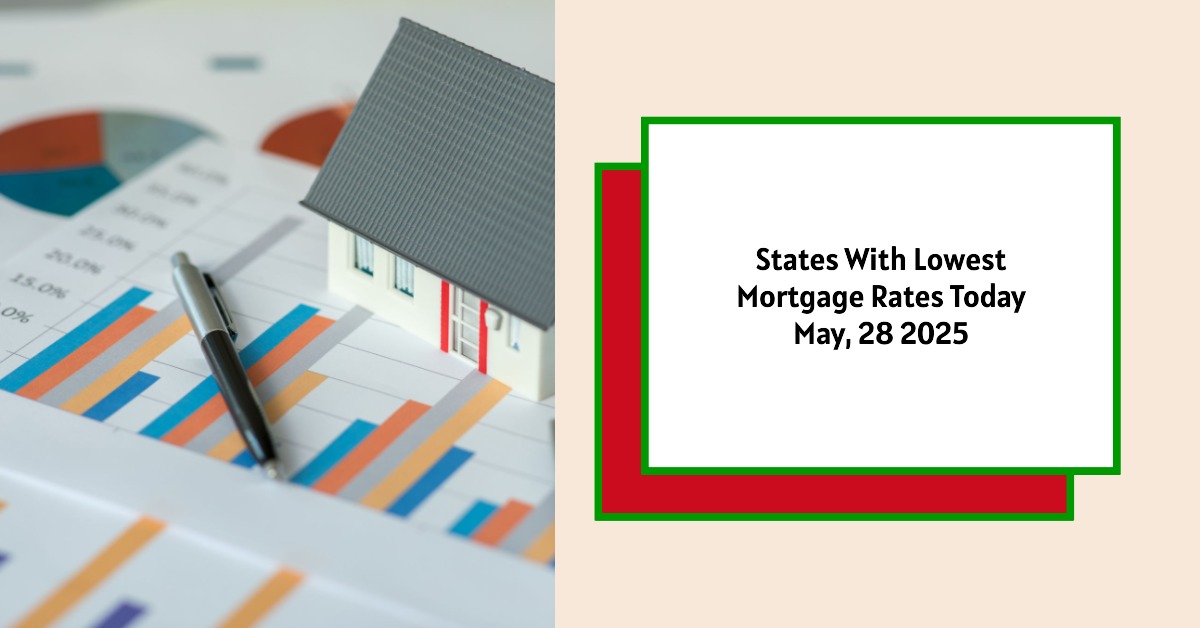Looking for the states with the most affordable mortgage rates today? As of May 28, 2025, the states offering the lowest 30-year new purchase mortgage rates are New York, California, Florida, Pennsylvania, Hawaii, North Carolina, and Tennessee, with rates averaging between 6.89% and 7.04%.
States With Lowest Mortgage Rates Today – May, 28 2025
Buying a home is one of the biggest decisions most of us will ever make, and understanding mortgage rates is a huge part of that process. It's not just about finding a place to live, but also about making a sound financial investment. The interest rate you lock in will impact your monthly payments and the total cost of your home over the life of the loan. So, let's dive deep into the current mortgage rate scenario, particularly focusing on which states are offering the best deals as of today, May 28, 2025, and why rates vary so widely.
Understanding the Current Mortgage Rate Climate
Before we zero in on specific states, let’s take a bird's-eye view of what’s happening with mortgage rates nationally. According to Zillow, the national average for a 30-year new purchase mortgage stands at 7.06%. This reflects a slight decrease from a recent high of 7.15% earlier in May but is still significantly higher than the 2025 low of 6.50% seen in March. This ever-changing scene can make your head spin!
Here's a quick breakdown of national averages for different loan types:
- 30-Year Fixed: 7.06%
- FHA 30-Year Fixed: 7.37%
- 15-Year Fixed: 6.07%
- Jumbo 30-Year Fixed: 7.01%
- 5/6 ARM: 7.18%
The States with the Lowest Mortgage Rates
Now, let's get to the heart of the matter: the states where you can snag the most favorable mortgage rates right now. As mentioned earlier, these states are leading the pack:
- New York
- California
- Florida
- Pennsylvania
- Hawaii
- North Carolina
- Tennessee
These states boast 30-year mortgage rates ranging from 6.89% to 7.04%.
What's interesting is that these states are quite diverse in terms of their economies and demographics. This tells me that there isn't one single factor driving down rates across the board.
The States with the Highest Mortgage Rates
On the flip side, some states are experiencing higher mortgage rates. As of today, May 28, 2025, these states have the highest 30-year mortgage rates:
- Alaska
- Washington, D.C.
- West Virginia
- Iowa
- Mississippi
- New Hampshire
- North Dakota
- Minnesota
- Nevada
In these states, the average 30-year mortgage rate ranges from 7.11% to 7.20%.
Why Do Mortgage Rates Vary By State?
You might be scratching your head wondering why mortgage rates aren't uniform across the country. There are several factors at play:
- Lender Presence and Competition: Different lenders operate in different regions, and the level of competition among them can influence rates. More competition typically leads to lower rates.
- State-Level Regulations: Each state has its own set of regulations governing the mortgage industry. These regulations can impact the cost of doing business for lenders, which can then be reflected in the rates they offer.
- Credit Scores and Loan Sizes: The average credit score and loan size within a state can also play a role. States with higher average credit scores might see slightly lower rates, as lenders perceive less risk. Similarly, states with larger average loan sizes might also have different rate structures.
- Risk Management Strategies: Lenders have their own unique ways of assessing and managing risk. Some lenders might be more aggressive in certain markets, offering lower rates to attract more business.
- Economic Health: A state's overall economic health impacts its real estate market, which in turn affects mortgage rates. A strong economy usually correlates with stable or decreasing rates.
What Affects Mortgage Rates In General?
The factors impacting mortgage rates at the state level are just the tip of the iceberg. Let's zoom out to look at the bigger picture. Several macroeconomic and industry forces influence mortgage rates:
- The Bond Market: This is a big one. Mortgage rates tend to track the yield on 10-year Treasury bonds. When bond yields rise, mortgage rates usually follow suit, and vice versa.
- Federal Reserve Policy: The Federal Reserve (the Fed) plays a crucial role. Their monetary policy, especially how they manage bond buying and funding for government-backed mortgages, can significantly impact rates. In 2021, the Fed's bond-buying kept rates low, but as they reduced these purchases, rates began to climb.
- Inflation: High inflation usually pushes mortgage rates higher. Lenders want to protect themselves against the eroding effect of inflation on their returns.
- The Federal Funds Rate: While the fed funds rate (the rate banks charge each other for overnight lending) doesn't directly determine mortgage rates, its changes certainly influence them. The Fed's aggressive rate hikes in 2022 and 2023 to combat inflation had an indirect but powerful upward effect on mortgage rates.
- Overall Economic Conditions: A strong economy generally leads to higher demand for homes, which can push rates up. Conversely, a weaker economy might lead to lower rates to stimulate borrowing.
Read More:
States With the Lowest Mortgage Rates on May 27, 2025
Projected Mortgage Rates for the Week of May 5-11, 2025
When Will Mortgage Rates Go Down from Current Highs in 2025?
How to Find the Best Mortgage Rate for You
Okay, so now you know which states have the lowest average rates and what factors influence those rates. But remember, these are just averages. The rate you actually get will depend on your individual circumstances. Here's what you can do to secure the best possible mortgage rate:
- Shop Around Extensively: Don't settle for the first offer you receive. Get quotes from multiple lenders – banks, credit unions, and online mortgage companies. Each lender has different criteria and may offer you a different rate.
- Improve Your Credit Score: This is huge. A higher credit score signals to lenders that you're a low-risk borrower. Even a small improvement in your credit score can translate into a lower mortgage rate. Pay your bills on time, keep your credit card balances low, and correct any errors on your credit report.
- Increase Your Down Payment: A larger down payment reduces the amount you need to borrow, which can also lead to a lower interest rate. It also demonstrates to the lender that you have more at stake, making you a less risky borrower.
- Consider Different Loan Types: Explore different mortgage options, such as fixed-rate mortgages, adjustable-rate mortgages (ARMs), and FHA loans. Each type has its own pros and cons, and one might be a better fit for your situation than others. However, I would personally stick to fixed rate options unless you are sure of what you are doing.
- Pay Attention to Points and Fees: Mortgage rates aren't the only cost to consider. Pay attention to any points (upfront fees you pay to lower your interest rate) and other fees associated with the loan. Sometimes, a slightly higher rate with fewer fees can be a better deal in the long run.
Using a Mortgage Calculator
Mortgage calculators are great tools to help you estimate your monthly payments. You can experiment with different home prices, down payments, loan terms, and interest rates to see how they impact your monthly costs. Keep in mind that calculators provide estimates, and your actual payments may vary.
For instance, let's say you're looking at a home priced at $440,000, and you have a $88,000 down payment (20%). With a 30-year loan and an interest rate of 6.67%, your estimated monthly payment would be around $2,649.04. That's broken down into $2,264.38 for principal and interest, $256.67 for property taxes, and $128.00 for homeowners insurance.
The Bottom Line
Mortgage rates are a moving target, influenced by a complex web of economic factors. While some states currently offer lower average rates than others, the rate you ultimately secure will depend on your individual financial profile and the choices you make. By shopping around, improving your credit score, and understanding the different loan options available, you can increase your chances of landing a favorable mortgage rate and achieving your homeownership dreams.
Invest in Real Estate in the Top U.S. Markets
Investing in turnkey real estate can help you secure consistent returns with fluctuating mortgage rates.
Expand your portfolio confidently, even in a shifting interest rate environment.
Speak with our expert investment counselors (No Obligation):
(800) 611-3060
Also Read:
- Will Mortgage Rates Go Down in 2025: Morgan Stanley's Forecast
- Expect High Mortgage Rates Until 2026: Fannie Mae's 2-Year Forecast
- Mortgage Rate Predictions 2025 from 4 Leading Housing Experts
- Mortgage Rates Forecast for the Next 3 Years: 2025 to 2027
- 30-Year Mortgage Rate Forecast for the Next 5 Years
- 15-Year Mortgage Rate Forecast for the Next 5 Years
- Why Are Mortgage Rates Going Up in 2025: Will Rates Drop?
- Why Are Mortgage Rates So High and Predictions for 2025
- Will Mortgage Rates Ever Be 3% Again in the Future?
- Mortgage Rates Predictions for Next 2 Years
- Mortgage Rate Predictions for Next 5 Years
- Mortgage Rate Predictions: Why 2% and 3% Rates are Out of Reach
- How Lower Mortgage Rates Can Save You Thousands?
- How to Get a Low Mortgage Interest Rate?
- Will Mortgage Rates Ever Be 4% Again?



